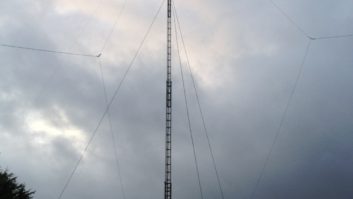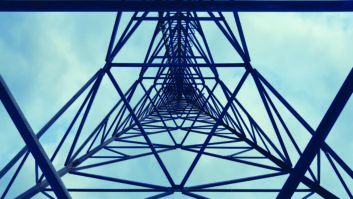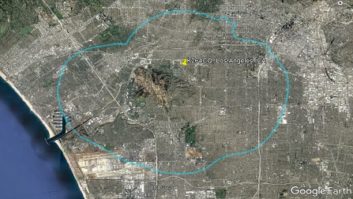The useful folded unipole
Oct 1, 2001 12:00 PM, By Ron Nott
One of the advantages claimed for the folded unipole is its broad bandwidth. However, years of experience have shown that this can vary greatly depending on several factors, mainly overall tower height.

Fifteen years ago, a station installed a unipole with bandwidth that was almost unbelievably broad. The engineer told me that he fudged the impedance measurements slightly because they were so good that he was concerned that the FCC might question them. It was then realized that the bandwidth of the unipole could be extremely good under certain conditions and poor under others. Determining these conditions can be elusive.
The late John H. Mullaney was the pioneer of this antenna, and he had Dr. Jerry Raines write a computer program specifically for its design. While this program is now old in terms of computer technology, it is still valuable and reveals how an antenna may be designed to optimize the bandwidth.
One advantage of the folded unipole is that is can provide a higher value of resistance than a conventional series-fed antenna when the antenna must be electrically short, i.e., less than one-quarter wavelength (90�) in height. For antennas around 60� in height, an adequate resistance can be obtained with a unipole, but the bandwidth is usually narrow. There are modifications that can be applied to broaden it, but it is normally not ideal.
Alternatively, when a folded unipole is installed on a tall tower that approaches one-half wavelength (180�), the bandwidth may also become a problem, and modifications must be applied to obtain reasonable values of both impedance and bandwidth.
A folded unipole antenna may be loosely described as a length of coaxial cable stood on end with the center conductor grounded and the wire skirt simulating the outer conductor. The radiation from it makes it look like a lossy length of line, but several characteristics are similar to a transmission line.
Physical parameters of the tower and its surroundings can influence the antenna’s performance.

The tuning stub height is analogous to a short across a length of transmission line some distance away from the generator or drive point. Moving it up or down affects both the resistance and the reactance seen at the generator.
Normally, the stub is adjusted to present the desired value of resistance (usually 50O). The reactance is usually inductive, and a series capacitor may be placed in series with it to resonate the antenna.
The industry standard
The series-fed, quarter-waveantenna has become the standard of the industry because it has the minimum height at which a reasonable value of resistance with low reactance can be obtained. This means that the antenna tuning unit can consist of a simple Tee network, and the radiation efficiency will be reasonably good. There is nothing magic about a quarter-wave antenna, it merely makes for a convenient antenna treatment. Referring to FCC Rule 73.190, fig. 8., you will not find a sudden rise in field intensity or any other advantage. Taller antennas have higher gain, but at the cost of a taller tower.
While the above discussion pertains to the conventional series-fed antenna, in general the same principles apply to the folded unipole except for the impedance values. An untuned quarter wave unipole would have high values of resistance and inductive reactance at its impedance. Fortunately, the antenna is easily stub tuned to present a better resistance value such as 50O, but there will normally be a value of inductive reactance that may be cancelled by a series capacitor to resonate the antenna.
Best height for broadband
Much experience has shown that while the quarter-wave folded-unipole normally has fairly good bandwidth, it becomes extraordinary when the antenna is slightly taller. This is confirmed by the Mullaney Engineering program and several cases of actual field experience. While there are variables that must be considered, if the antenna height is between 105 and 115 electrical degrees tall, the bandwidth is extremely broad. Other factors are tower cross-section, spacing of the skirt wires from the tower, the number of skirt wires and the skirt wire diameter. Variables more difficult to deal with are found in the environment around the antenna, such as metal structures, power lines, ground characteristics, etc.
The entire tower does not need to be used as the radiator, particularly if the tower is very tall.

Using the Mullaney program and applying years of experience, an antenna can be designed and built with excellent bandwidth for AM stereo or digital (IBOC) transmission. In the expanded band where tower height is relatively short, adding a small amount of height can result in a real improvement in bandwidth over a quarter-wave antenna. This height increase becomes proportionally greater at lower frequencies, but in the upper portion of the AM band, it may be practical to increase tower height slightly and install a bandwidth-optimized folded-unipole antenna to realize the full advantages of stereo or digital transmission. On a taller tower, the upper portion of the tower may be detuned, leaving an optimum height antenna below it.
Impedance matching can be as simple as setting the antenna tuning stub for 50O resistance and then resonating the antenna with a series capacitor at its input. There was a time when it was desirable, and often necessary, to use a Tee network at the input to an antenna to attenuate harmonics, but all AM transmitters accepted since 1960 are required to have adequate spurious-emission attenuation built into the output network. It is no longer necessary to use a Tee network for harmonic attenuation. In fact, unless it has been specifically designed and tuned for broad bandwidth, a Tee network may function as a bandpass filter, which can attenuate sideband energy, defeating the broadband characteristic of a bandwidth optimized folded-unipole antenna.
Tall towers
In many cases, an existing or new tower for another service may be used as an AM broadcast antenna, even if it is too tall for the AM frequency, as is often the case with an FM tower. In this case, the upper portion of the tower below the FM antenna may be detuned to produce the optimum height for the AM antenna. This allows the AM antenna to be bandwidth-optimized, while the detuning skirt makes the tower above it effectively disappear.
This method allows consolidation of the AM and the FM transmitter sites using a grounded tower, which eliminates the need for isocouplers. Bear in mind that if an existing tower is to be considered for AM service, the guy wires must be segmented with insulators, as is the case for any guyed tower used for AM. Unfortunately, this may cost more than the folded unipole antenna and detuning skirt.
While the advantages of a folded unipole antenna are well known, optimizing one for bandwidth is frosting on the cake. If your station is considering either stereo or IBOC digital broadcasting, you should take a hard look at the bandwidth optimized folded unipole antenna. The system bandwidth of an AM transmission system includes the transmitter, the transmission line, matching network and antenna. The transmission line becomes important if any sideband energy is reflected from the antenna and/or tuning unit. A Smith chart shows what happens to this energy if you don’t have an adequately broad bandwidth for the transmitter load. It can have a negative effect on your signal.
The RF system must be considered as a whole, and if any part of it has limited bandwidth, the quality of your transmission may suffer. Stereo and digital AM broadcasting require greater bandwidth than mono AM. Even if your system seems to be good now, it may not perform well with more complex methods of modulation in the future. If you want perfection for your transmission, consider the bandwidth optimized folded unipole antenna.
AM does not have to take a back seat to FM in quality of sound. All it needs is good bandwidth from the audio sources to the antenna.
Ron Nott is president of Nott Ltd., Farmington, NM.
The Mullaney Unipole program, copyrighted by Mullaney Engineering Inc., is available through the company by calling 301-921-0115.











